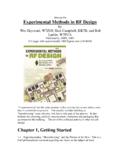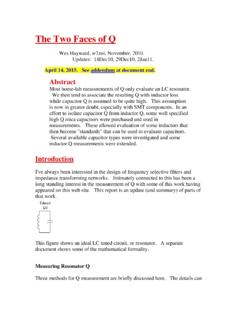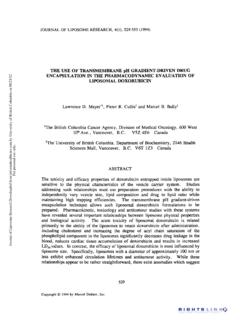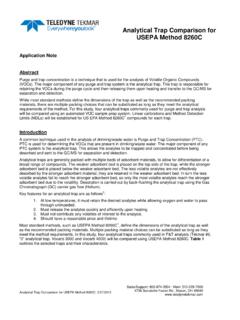Transcription of Advancements in the EmabondTM Induction Welding …
1 Advances in the EmabondTM Induction Welding process for High-Performance Assembly of Demanding Thermoplastics Russell J. Nichols, PE Ashland Specialty Chemical Co. Abstract Electromagnetic (or Induction ) Welding of thermoplastics is a simple, rapid and reliable assembly technique that produces structural, hermetic or high-pressure seals for most thermoplastic materials. Fusion temperature at the abutting interface of the parts to be bonded is achieved by using a specially formulated thermoplastic resin to absorb energy provided by an RF Induction field. The process is widely used for such difficult-to-join materials as polyolefins and nylons.
2 In addition to homogeneous polymers, the process can bond filled and/or glass fiber reinforced polymers to themselves or to selected dissimilar thermoplastics. The presentation outlines the design and manufacturing considerations implemented to achieve reliable, robust performance and details the advances and use of this process in several representative high-performance assembly applications. Introduction Welding of thermoplastic components is achieved when sufficient energy is introduced at the interface of the parts for local melting and fusion to occur. Various energy sources can be employed ( , a part can be heated to its fusion temperature by conductive heat transfer, mechanical energy can be dissipated by rotation or oscillation, and, ultrasonic or IR/laser energy can be delivered to bond interfaces).
3 The application of mechanical energy and/or conductive heating causes displacement of material at the heated surfaces due to deformation. This flow at the interface may lead to dimensional variation in the finished assemblies and/or flow of excess material to the surface of the joined parts. Electromagnetic Welding is an alternative joining method in which Induction heating provides a means of precise delivery of energy to a designed joint in which an implant material selectively absorbs energy, melts and flows to fill the joint. Resulting joints combine high strength sufficient for structural, hermetic or high-pressure seals with dimensional stability and aesthetically pleasing appearance.
4 Induction Heating Technology Electromagnetic (or Induction ) heating results when a conductive material is placed in a varying magnetic field. The heating results from both eddy currents and hysteresis losses, with the relative magnitude of the two depending upon the magnetic properties Page 1 of the material to which the field is applied. In conductive, non-magnetic materials, only eddy current heating is possible, while in conductive, magnetic materials, both eddy current and hysteresis heating occurs. In this process , ferromagnetic materials (susceptors) are mixed into polymers (matrix materials) to form proprietary compounds.
5 The resulting compounds are applied to joints in the form of precision extruded profiles such as strand or tape, or as molded gaskets. Because the susceptor materials are distributed in a non-conducting polymer matrix, the resulting compound exhibits low electrical conductivity. This limits eddy current circulation (and the resultant Joule heating) in the same manner that laminated cores break the path for eddy currents in electrical transformers. Therefore, the primary mode of heating with these compounds is hysteresis losses. Hysteresis heating occurs when magnetic materials are subjected to rapidly alternating (high frequency) magnetic fields.
6 Magnetic hysteresis can best be visualized by plotting field intensity (H) versus magnetic Induction (B) as shown in Figure 1. The initial magnetization curve ( , the point at which the energy is first applied to the susceptor) starts at the origin (H0B0) and continues until the field intensity reaches the maximum value (Hmax) in the upper right quadrant. Thereafter, at each cycle of the applied RF field, the susceptor responds by completing the full cycle described by the dotted line. The area bounded by the hysteresis curve is proportional to the energy converted into heat. High frequencies are required because the incremental temperature rise for each hysteresis cycle is very small.
7 Induction Welding process Principles and Equipment The Welding process begins with placement of the lower half of the part in the press, followed by insertion of the susceptor material, and placement of the upper half of the part in the press. As illustrated in Figure 2, the parts are held in close alignment to the work coil that delivers the Induction energy by suitable fixtures. During joining, low pressure is applied to the parts until the heating is sufficient for the susceptor compound to reach its melt temperature initiating flow, and then high pressure is briefly applied to assure that the final positioning of the parts is correct.
8 After joining, the susceptor compound has filled the designed gap in the joint and fused the mating parts, resulting in a polymer-to-polymer permanent bond. The Induction Welding system includes an RF generator, application geometry specific work coils, an assembly press and tooling, the associated controls [ , a programmable logic controller (PLC) and human-machine-interface (HMI) or equivalents], the components to be joined, and the susceptor material. The key process interaction is that between the work coils and the susceptor material. The work coil can be thought of as an RF antenna and the generator is an RF transmitter.
9 The generator/work coil system has to be tuned to perform properly. Although RF energy has the ability to propagate through air, it is known that the intensity of the field follows an inverse square function, so uniform heating is best achieved by maintaining a uniform distance between Page 2 the work coil and the bondline. Very long bondlines are often a great challenge to other joining methods, but Induction Welding is ideally suited to such components. Work coils have been designed to weld very large parts or to weld multiple (coils for up to 20 individual welds performed simultaneously are in commercial use) smaller parts simultaneously.
10 Much of the proprietary technology involved in this field involves the design of the work coils to assure uniform heating performance. The performance of the energy delivery system is meaningless except in the context of the effective heating of the susceptor compound in the joint. Material science considerations are involved in all susceptor formulations, in both the choice of matrix polymers and ferromagnetic susceptors. The polymer matrix material must be compatible with the parts to be joined. In the case of dissimilar polymers, great care must be taken to select materials with the capability of bonding with both substrates.







